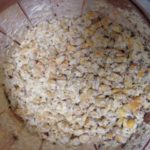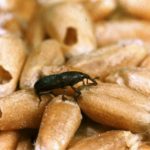One day this winter at the research station, an administrative assistant discovered many very small, brown insects crawling on the floor and wall near the bottom of a stairwell. She brought them to the attention of the Bugs Crew and Dr. Stewart identified them as granary weevils (Coleoptera: Superfamily Curculionidae: Subfamily Dryophthorinae). He then knew that there was some corn or other whole grain somewhere nearby that these weevils were feeding on. Indeed, there were some small baskets of shelled field corn used in an educational display, but now stored in a closet, that were heavily infested with these pests.

The insect superfamily Curculionidae is the biggest family of weevils and actually the biggest family of living things on Earth. There are in fact more species of weevils than there are vertebrates. North America is home to about 3,100 of the world’s 60,000 weevil species. Many weevils are serious pests of food and fiber. Granary weevils, (Sitophilus granarius), also known as grain weevils or wheat weevils, occur all over the world and are serious pests of many grains, especially stored harvested grain, including wheat, oats, rye, barley, rice and corn.
The most identifying characteristics of weevils are their easily recognizable shape and their almost comically elongated snout. Adult granary weevils are about 2 – 4 mm (1/8th

Photo credit: NC State
inch) long and have slender, hard-shelled bodies that appear pitted or scarred with tiny holes. They are brown to reddish brown in color, are uniformly colored with no spots. When disturbed, the adult weevils will ‘play possum” by pulling their legs in close to their bodies and pretending to be dead. Interestingly, adult granary weevils cannot fly and so are most likely found where grain is stored. They can be spread with infested grain.
Female weevils lay between 50 and 200 eggs, one egg per kernel. The hatched larvae consume the inside of grain kernels until they pupate, after which they bore a hole through the seed coat and emerge. In warm temperatures, the granary weevil can develop from egg to adult in approximately five weeks. Colder temperatures slow life cycle development.
For information about the prevention and control of insects in grain bins and how to sample for these insects, please refer to the Stored Grain section on UTCrops.com and related links: http://www.utcrops.com/stored_grain/pubs.htm
http://www.utcrops.com/stored_grain/sg_links.htm
References:
Marshall, S. A. 2006. Insects: Their Natural History and Diversity. Firefly Books Ltd. Buffalo, NY 14205. Pgs. 281 – 282, 371.
Penn State University. http://ento.psu.edu/extension/factsheets/weevils-on-stored-grain

